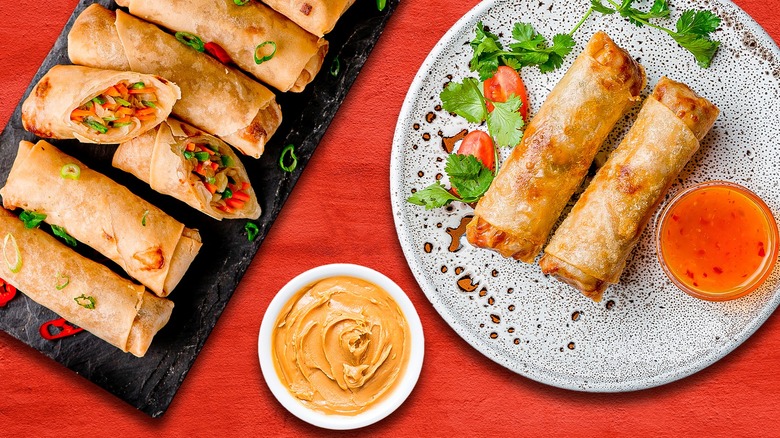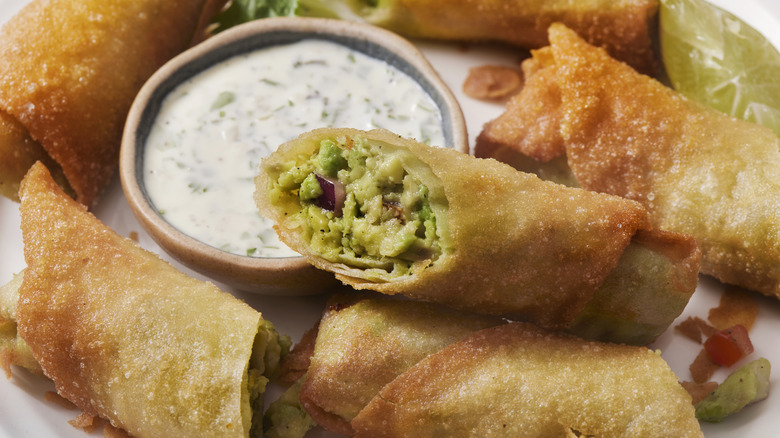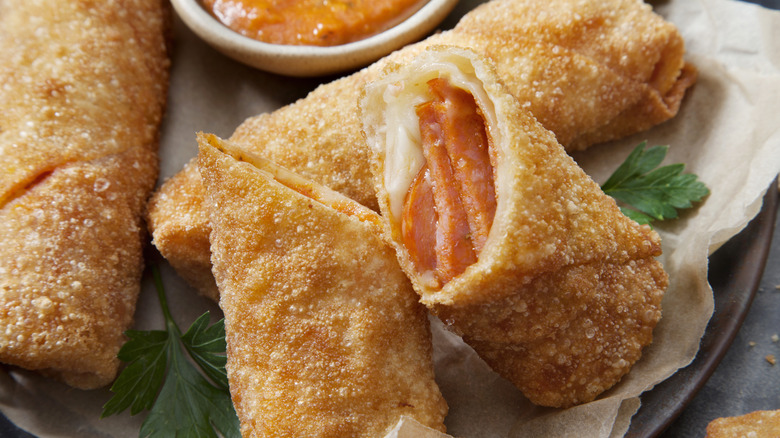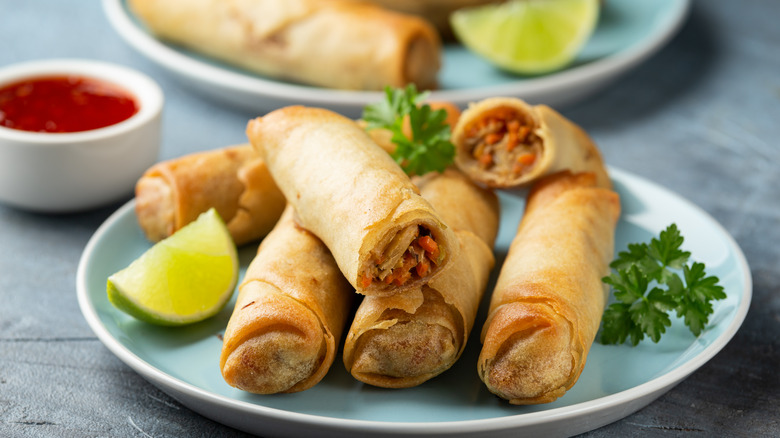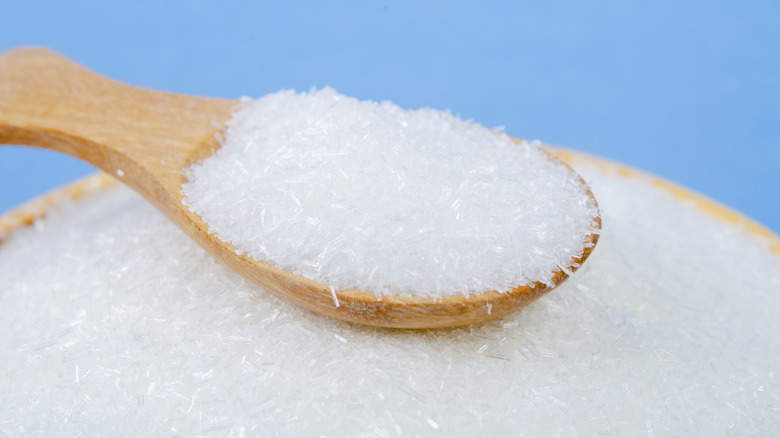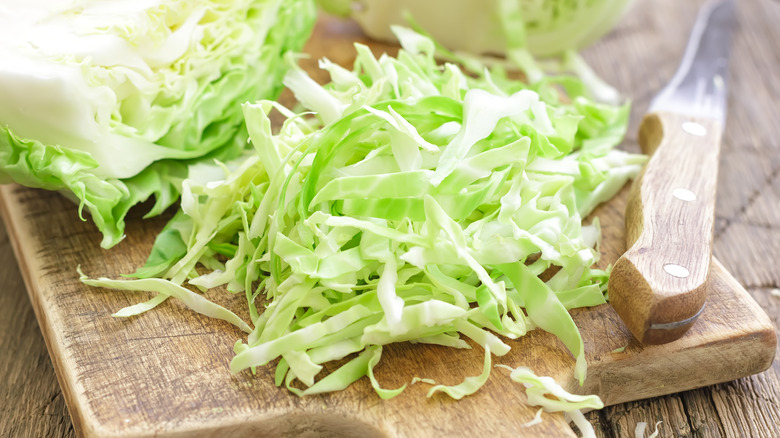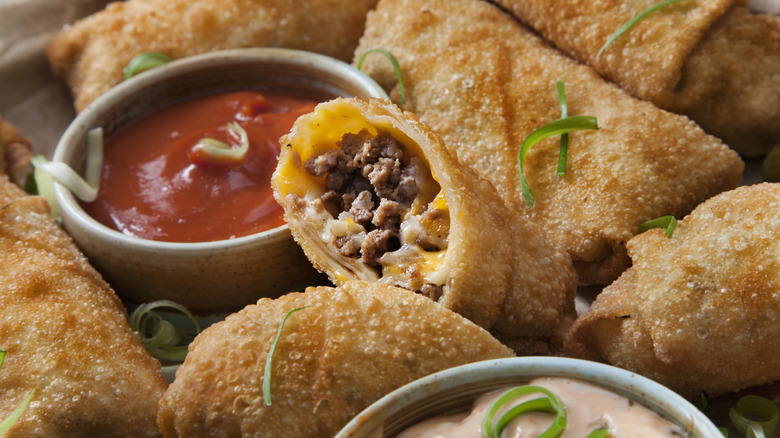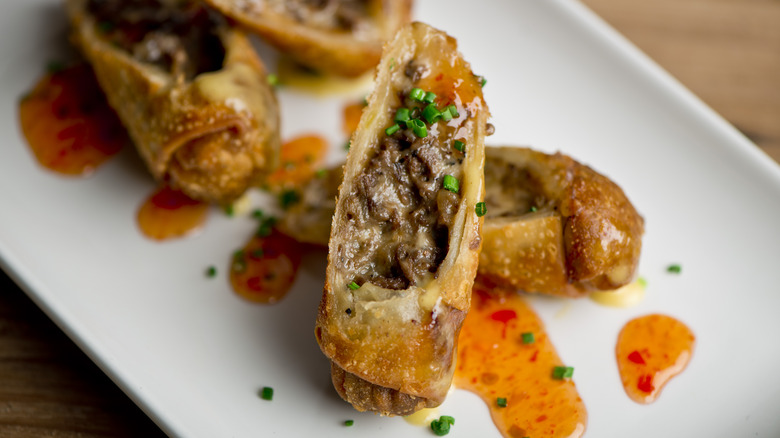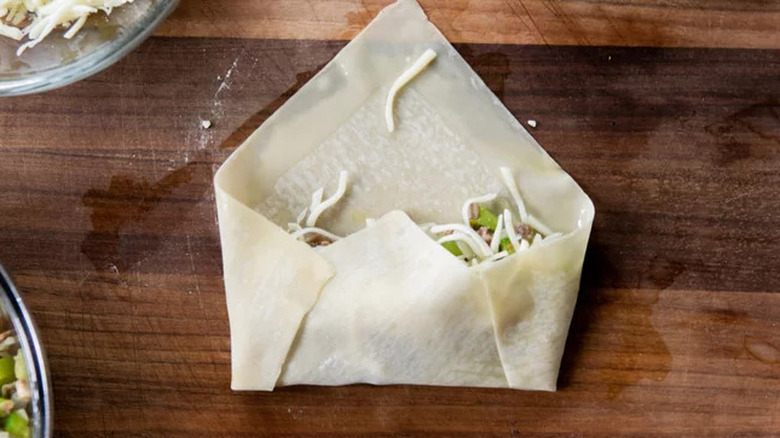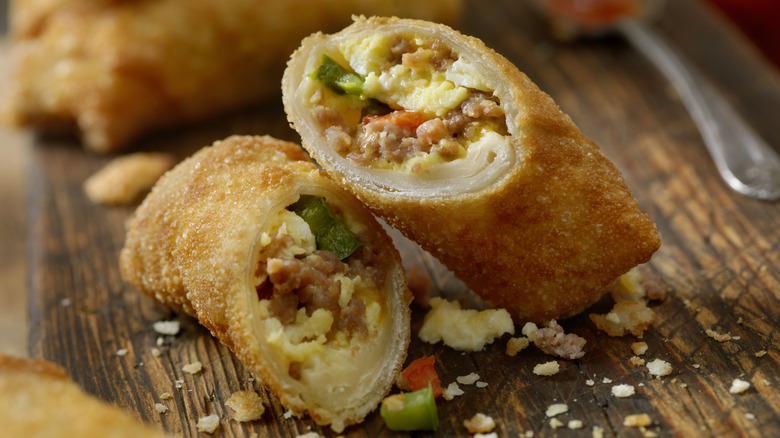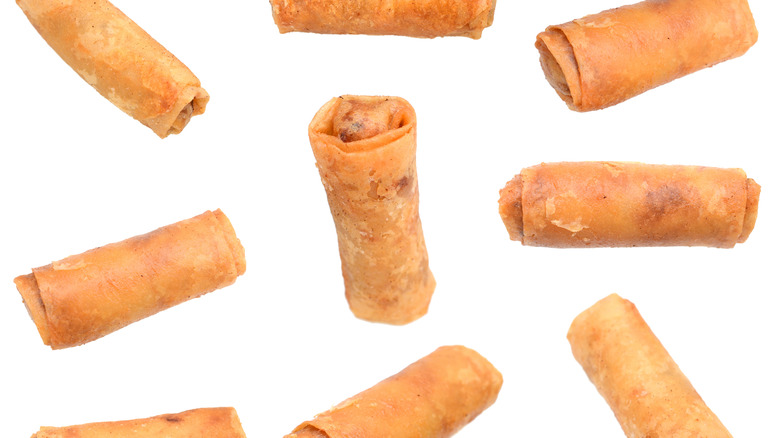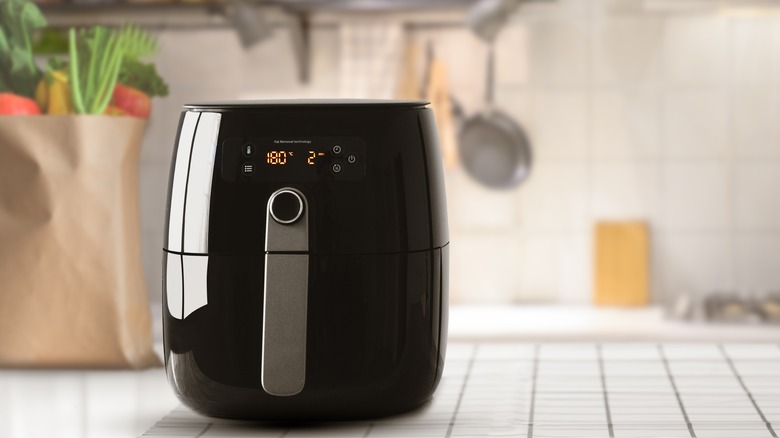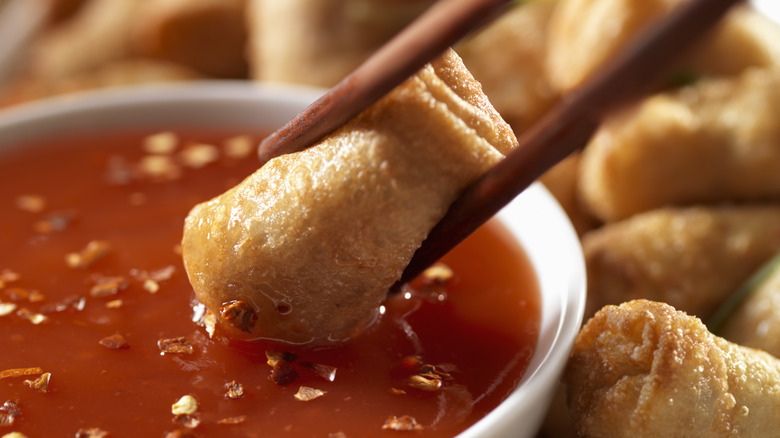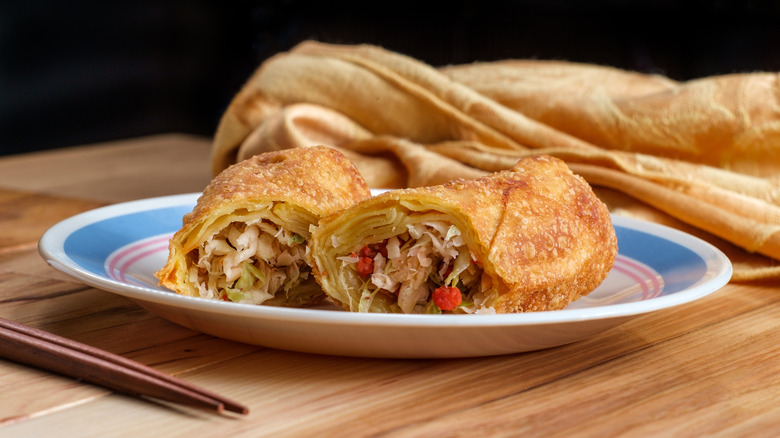15 Tips You Need To Make Egg Rolls Like Your Favorite Takeout Spot
There's nothing humble about the Chinese American takeout-style egg roll. Bold, bubbly, blistered, and with a crunch deserving of its own Richter scale, it holds its own against any deep-fried snack. A welcome appetizer, or, indeed, a full meal in its own right, egg rolls — which don't necessarily need even to contain eggs — are welcome on any plate. While its origins remain disputed, author of "Chop Suey: A Cultural History of Chinese Food in the United States" Andrew Coe, suggests the first egg roll could have sprung into existence on an auspicious day in the 1930s in some deep fryer basket at a Chinese restaurant in New York City. Equally possible, egg rolls may have evolved from Dan Gun instead (which literally translates to 'egg roll'), a Chinese American snack where fillings are wrapped in an omelet.
Not to be confused with Chinese spring rolls (Chinese American egg rolls are a lot thicker than their traditional cousins), the jury might be out on how and where they came to be. However, we can all agree these moreish golden cylinders are here to stay. Of course, you could hop to your most beloved Chinese takeout to snag yourself a haul, but you could make them yourself instead, which will be infinitely more delicious. From homemade wrappers and new wave fillings to preparation techniques that could make or break your meal, deep frying hints, and how to resurrect leftovers, we've rounded all the tips to making egg rolls like your favorite takeout spot.
Ditch the store-bought wrapper
Egg rolls are so darn delicious you'll want to be able to whip them up at a minute's notice. Better still, if you know how to make them yourself, you can elevate even the most mundane leftovers on a whim. Besides, everything tastes better when you've made it from scratch. Fortunately, egg roll wrappers can be made from just four key ingredients — wheat flour, salt, eggs, and cornstarch. Keep these in your pantry (chances are they're there already) for endless egg rolls, which is exactly how we like them.
If you follow this simple egg roll wrapper recipe, it'll take less than an hour to make a mountain of wrappers, from dough to go. While you technically can make the dough three days before you intend to use it, it's better to get rolling as quickly as possible. Be sure to sprinkle cornstarch between the wrappers or separate with parchment paper to prevent them from sticking together.
Egg rolls have infinite potential
Egg rolls are an opportunity to flex your culinary creativity. Classic egg roll recipes call for roast pork; shredded vegetables like cabbage, carrot, celery, and spring onions; sesame oil, and Chinese seasonings, but don't let that stop you from manifesting the egg roll of your dreams, or, at least, of your latest craving.
Wishing you could wrap your mouth around a crispy Philly cheesesteak egg roll? Wish granted. Curious about what a Reuben would be like in egg roll form? Get ready to drool over this Reuben egg roll recipe. There's even an egg roll method for stuffed fried pickles. Or maybe you're just after a meat-free iteration of the classic that's still packed with that tasty umami flavor, and that's very doable, too. This vegetarian egg rolls recipe substitutes ground pork for shitake mushrooms and combines them with shredded cabbage and carrots seasoned with garlic, ginger, soy sauce, and sesame oil.
There's a passable gluten-free alternative
Egg roll wrappers contain flour, so they're not suitable for gluten-free diners. Luckily, though, it's easy to accommodate this dietary requirement; simply substitute regular flour for a 1 to 1/3 blend of gluten-free and sweet rice flour so everybody can get their egg roll fix. The wrapper might not be quite as blistered and bubbly as the gluten-rich original, but we're sure everyone will agree that an egg roll variant is better than no egg roll at all.
As for the fillings, plain meat and vegetables are naturally gluten-free, but be sure to check any seasonings and sauces for wheat. Soy sauce is a common ingredient in egg roll fillings. While there are many types of soy sauce, the shoyu variety appears most commonly in the United States and is made with wheat and yeast, so it isn't gluten-free. Still, you can easily substitute this for tamari or liquid aminos.
Don't shy away from MSG
The scariest thing about monosodium glutamate (MSG) is the rampant anti-Asian (and particularly anti-Chinese) racism that took hold of the Western world in response to an unproven, anecdotal claim published in 1968 that suggested it caused negative health effects. There's no science to support this claim, and the FDA labels MSG as "generally recognized as safe."
In fact, we crave MSG. It gives us that highly-coveted umami flavor and occurs naturally in kombu kelp, soy sauce, shiitake mushrooms, parmesan cheese, sun-dried tomatoes, green tea, and more. It also appears in Doritos, some ramen, and chicken bouillon. The latter is commonly used by Chinese takeout restaurants and, specifically, in the creation of some of the tastiest and best egg rolls around. So, if you are indeed on a mission to make egg rolls like your favorite takeout spot, you should add a sprinkle of this "tasting powder" into your vegetable mix.
Drain your vegetables
A euphoric egg roll-eating experience begins with a crunch as you bite through a crispy outer layer. Your teeth then sink into a mix of soft shredded vegetables and delectable meat, and a heavenly spiced aroma envelops you. But egg roll euphoria is abruptly stopped in its tracks if you're unlucky enough to bite into a mushy roll.
Egg rolls are relatively easy to make yourself, and if you're whipping up a batch of egg rolls, chances are you want to eat them, stat, but rushing the preparation process can doom your egg rolls to a mushy demise, especially when it comes to the vegetable component of your filling. The usual veggie prep process is to shred, wash, and then sauté them, but before they hit that pan, you've got to leave them to drain. Vegetables have a high water content, so draining before and after cooking — ideally in a strainer for at least an hour — will remove excess water, meaning it's less likely to mess with that sacred crunch.
Use fresh meat in your egg rolls
Turning your leftovers into egg rolls might make you feel virtuous, and rightly so (food waste isn't a vibe), but it's best to use fresh meat for egg rolls. Freshly cooked, high-quality meat is juicier than meat that's been in the fridge for a couple of days. There's also a process that happens to meat the longer it sits around for — oxidation. Essentially, oxygen in the air reacts with the fat in the meat, producing byproducts that taste and smell bad. One of these reactions is known as the "warmed-over flavor." You've experienced it if you've ever eaten reheated meat and noticed it tastes strange, but you struggle to articulate how.
Some leftovers, however, might actually be worthy of a second life as an egg roll. Meat seasoned with herbs might avoid developing undesirable flavors because herbs contain antioxidants that slow the oxidation process, and meat from a stew or curry stands to be more flavorful than when it was first cooked because spices become more established in a dish over time.
Don't overfill your egg rolls... or do
Most egg roll recipes recommend filling each wrapper with approximately ¼ cup of filling. But we're not above a jumbo egg roll and judging by the wild popularity of Mike Williams' (aka @ontheroll_eggrolls) super rolls, we're not alone. If you're taking a leaf out of Williams' recipe book, you're going to need to supersize your egg roll wrappers simply by doubling or tripling your wrapper recipe and then scaling up the filling accordingly.
Speaking of, Williams holds nothing back on the fillings front, with everything from chicken and waffles, crab and shrimp with cream cheese, and smoked turkey with mac and cheese, greens, and yams among the combinations in his epicurean resume. Keep in mind larger than normal egg rolls will take longer to deep fry as it takes more time for the heat to get to the center of the roll but as the old adage goes, good things come to those who wait. And giant egg rolls are absolutely worth it.
Wrap your filling like a pro
It doesn't matter how mouthwatering your fillings are; if you've wrapped your egg roll poorly, it won't make it out of the deep fryer alive. Not only would that be tragic, but it'll be all 'clean up on aisle four, and that's a load of cleaning admin we're pretty sure you don't want to deal with.
For starters, wrap just one egg roll at a time, reserving the other wrappers under a damp paper towel in the interim to keep them pliable. Place your first wrapper in front of you in a diamond orientation, flour side down, and add your filling. Next, egg wash a thick border along each side, then fold it into an open envelope shape. You can do this by folding the bottom edge up so that it just covers the filling and mirrors the top corner of the wrapper, then fold the two side corners in, too. From here, gently pick up the bottom of the envelope and roll it towards the open end so it forms a cylinder.
Use the best oil possible
Deep-fried food is only as good as the oil it was fried in. Every type of oil has a smoke point, which is defined as the temperature at which the oil begins to break down, leaving an undesirable bitter and burnt flavor. Food is generally deep fried at temperatures between 350 and 375 F, so oils with a smoke point beyond 375 F, like canola oil (400 F), and peanut oil (450 F), will be better than extra virgin olive oil (375 F) or butter (350 F), for example.
You should also keep your oil clean. Ideally, you won't be reusing oil but if you are, for better deep frying, you need to be filtering your oil. This means passing the oil through a strainer to remove any chunks of breadcrumbs, cheese, or anything else for that matter. Twice and thrice-fried food bits will burn, and the resulting bitterness will tarnish your egg rolls.
Fry egg rolls at a stable temperature
Deep-frying is a quick process, at least it should be. The oil should be heated to the desired temperature before your egg rolls go anywhere near it. Texturally, fried food has a crispy outer and a softer inner. Achieving this relies on the oil being hot enough. Deep frying egg rolls works because when hot oil touches the surface of an egg roll, the wrapper is immediately cooked and sealed. The inside then begins to heat up, converting water in the filling into steam, cooking the food from the surface inwards.
If the oil is too cool, you're likely to get greasy, sticky egg rolls. If it's too hot, they could emerge burnt on the outside and not fully cooked on the inside. Measuring the temperature of the oil using a purpose-built thermometer is useful. Alternatively, according to Tasting Table recipe developer Michelle McGlinn, you can tell if the oil isn't hot enough if it doesn't immediately bubble when the egg roll is added.
Avoid piling up cooked egg rolls
The only thing better than an egg roll is many egg rolls, so chances are, when you're cooking egg rolls, you're making a large batch and deep-frying them in lots. One of the reasons egg rolls are so satisfying is their crispy outer wrapper, and this is why you should never pile up cooked egg rolls. The golden pyramids may look appetizing, but they won't be for long — when it comes down to crunch time, there won't be one.
Egg rolls need space to cool, so it's best to either line them up on paper towels or a wire cooling rack after cooking with plenty of room between each one. Placed close together and on top of each other, the piping hot egg rolls will inadvertently steam each other. What is the result? A sad, soggy egg roll, and nobody's got time for that.
You don't have to use a deep fryer
If you don't have access to a Dutch oven or, for whatever reason, you don't want to deep-fry your egg rolls, recipe developer Michelle McGlinn assures us there's another way to make them: In the oven. Egg rolls baked in the oven won't be as gorgeously golden as deep-fried ones, but they'll be crispy enough, making oven-baked egg rolls a worthy snack.
You can prepare egg rolls for oven-baking exactly the same way as if you were deep-frying them. The only difference is how long it takes to cook, which is about 15 to 20 minutes. To give it a go, preheat your oven to 400 F, oil up your rolls, and then bake on a wire rack lined with a baking sheet. It's even quicker to air fry your egg rolls, which takes a grand total of 12 minutes.
Match your egg rolls to their perfect sauce
Sometimes, a dip is the hero of the snack — the bread, nacho, or fry is merely a vehicle for that saucy goodness, but while part of the charm of egg rolls is the satisfaction of plunging them into a dipping sauce if the roll's overpowered, you're doing yourself a disservice.
There's nothing wrong with a classic soy sauce or rice wine vinegar, soy, and sesame blend, but if you're eating meaty egg rolls, you can draw inspiration from the type of meat when choosing your sauce for a next-level feed. The sweetness of apple is exceptional with pork, so you could opt for a fruity sauce with your pork egg rolls like Duck Sauce, which is made with Turkish apricots. A zesty yuzu mayo could make chicken egg rolls pop, and a garlic-based sauce like aioli, hot sauce, or chimichurri could be a treat with seafood egg rolls.
Let egg rolls cool before storing
If your egg rolls are destined for a potluck, you need to store them in a way that will retain their hallowed crispiness. Start by leaving your rolls to cool down completely (defending them from hungry hands), then wrap them in aluminum foil and store them in an airtight container in the refrigerator. If you seal them away in a container while they're still warm, it'll be a one-way ticket to soggy rolls, which, according to NDTV Food, could increase the risk of food poisoning from salmonella bacteria.
Instead, get your egg rolls into the refrigerator within two hours of cooking, however. Leaving them out longer could also compromise food safety. Worst case scenario, if you're low on time, you could place your hot egg rolls in a dish (making sure they don't touch) in an ice water bath to speed up the cooling process.
Reheat them properly
Egg rolls are so moreish that a leftover one is a pretty rare phenomenon, but for those joyful moments where you find yourself with leftover egg rolls, it's essential to know how to reheat them properly. Of course, you can reheat them with an array of different appliances, including microwaving, deep frying, pan frying, air frying, or baking in an oven or toaster oven.
Yet, two-pronged attack of a blast in the microwave followed by an oven chaser is the absolute best way to reheat egg rolls. The first step ensures the roll is warmed from wrapper to center and is achieved with two minutes on low. The second step is longer — about seven to 10 minutes — and crisps them up. For this part, lightly coat the egg rolls in oil and pop them into an oven at 435 F, turning them over once the top part goes golden.
